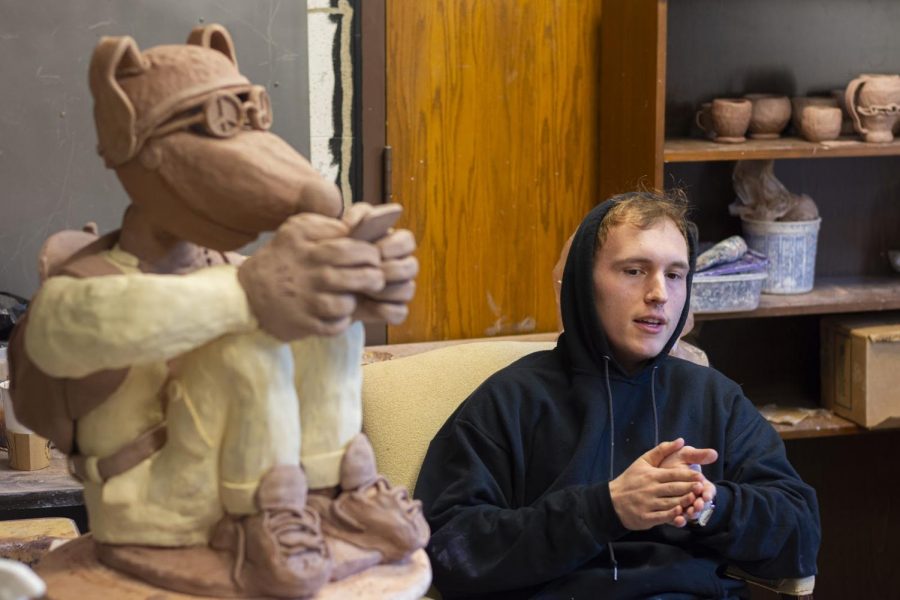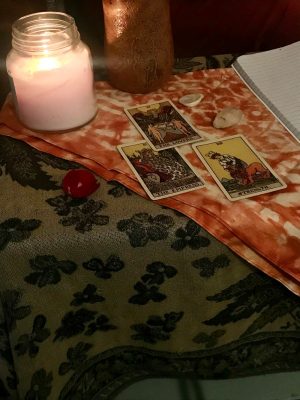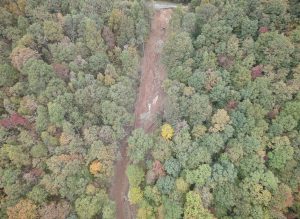The World Through Cartoons: A student’s journey through art
Henderson Button, a senior art studio major, primarily works with clay and paint and draws inspiration for his work from professors and fellow student artists alike. Button said the cartoon characters he primarily creates are meant to represent the world, versus literal figures.
February 18, 2020
A massive clay dog and a portrait of a smiling ghost accompany Henderson Button, a senior studio art major, in his Wey Hall studio space. Button uses clay and paints to craft characters representative of the world around him.
He began his work by building on ideas to develop a rhythm in his imagery. From drawing in his sketchbook, Button said he began seeing common threads he tied together to unify his world of characters.
“There were characters I would create, and I would start to see patterns and themes that would come about and think, ‘Oh, that’s cool, I want to explore that more.’ I would take that imagery and translate it to painting or clay,” Button said.
Button said through experimentation with different mediums, he realized his passion for working with clay and paint. While he has painted since his first year, he picked up on clay recently and uses it as a different means of translating his ideas.
“I started off mostly only drawing, like pen and ink drawing. I came here and took my first painting class, and I thought, ‘This is awesome. I want to keep doing this.’ I had a lot of friends that were doing clay and like a year ago, I started doing clay, too, and I fell in love with that,” Button said.
After watching a documentary on a painter’s life in an art class, he realized he could expand upon the traditional idea of how paintings are supposed to exist and appear to a viewer.
“I try to keep a look out for artists whose work I like. When I first got started painting, our professor showed us a documentary on Francis Bacon,” Button said. “I was like, ‘OK, this guy is cool, he was doing crazy work back in the 40s and 50s, so why can’t I do that now? Maybe painting doesn’t just have to be landscape and portraiture. Maybe it can be something else.’”
Button said Wey’s community atmosphere is an important aspect of his journey and communication between creative students is imperative to an artist’s success.
“I had a lot of great professors along the way, like Andréa Keys Connell, Hui Chi Lee (and) Mike Grady,” Button said. “I met a lot of people through Wey that I probably wouldn’t have met otherwise, a lot of really good artists that I’ve been able to have shows with and collaborate with. Being in a space with a lot of creative people has helped me a lot and pushed me to refine my work and how I work.”
The characters that Button brings to life through preliminary sketchbook drawings are inspired by his life experiences. Button said his art translates the world through stylized cartoon figures that represent his observations.
“The characters are an amalgamation of all of the drawings I was doing. The characters are somewhat a representation of myself but also a representation of the people I meet or the people in the world,” Button said.
Button said he chooses to use cartoon characters to represent the world versus real figures because of their symbolic meaning.
“Cartoon characters are really cool because it’s a figure, but it’s not a figure. It’s a representation that symbolizes how we think and feel and act,” Button said.
Button created a clay dog titled “One Chill Pup” is a piece to picture his generation’s reaction during potential war time. Button said he uses the dog character to represent his probable response to a draft.
“The idea for this piece is what would happen if someone in Gen Z got drafted for World War III. I was like, ‘Well, I wouldn’t want to shoot anybody, so he probably wouldn’t either.’ So, he’s using his own weapon: his cellphone,” Button said.
Portraying political themes was not always Button’s common practice. He has incorporated political ideas into his art after a resurgence of energy lost in the 2016 election.
“I came into the art program in 2016, so that was crazy with all of the political stuff that was happening. I feel like for while there, everyone was really burnt out over the election, and no one was making anything political or of that nature. It was only recently that I wanted to put that content back into the work,” Button said.
Beyond expanding his style, Button is working on his senior show and the Slop Drop, at the Nth Gallery & Studios. Button said it’s important to him and other members of the Nth Gallery & Studios to provide an inclusive environment for artists to showcase their work. Slop Drop, a community pop-up, will be held at the Nth Gallery & Studios on King Street during First Friday in March.
“(Slop Drop) is a way for artists in the community to get together and show their work without the pressure of having to cough up any money to the location,” Button said. “We want to create a space where people feel open, who maybe haven’t necessarily shown their work, to show their work.”











